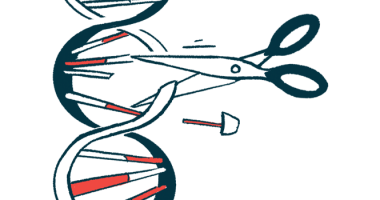CRISPR Gene Editing Restores Collagen Production in Mice
Production of type VII collagen was maintained up to 8 weeks after treatment

Getting gene editing based on CRISPR, a kind of molecular scissors, delivered directly into cells may help restore the production of type VII collagen, the protein that’s missing in patients with dystrophic epidermolysis bullosa (DEB), a mouse study found.
If the findings hold in humans, they “would allow the treatment of chronic open wounds that end up causing extensive tissue damage and deteriorating the patient’s quality of life,” the researchers wrote.
The study, “Preclinical model for phenotypic correction of dystrophic epidermolysis bullosa by in vivo CRISPR-Cas9 delivery using adenoviral vectors,” was published in Molecular Therapy Methods & Clinical Development by researchers in Spain in collaboration with colleagues in the U.K.
Epidermolysis bullosa diseases cause the skin to become fragile and blister or tear easily. In people with DEB, this can happen in response to even the smallest trauma, sometimes just rubbing or scratching, and often occurs in the hands, feet, arms, and legs.
DEB is caused by mutations in COL7A1, a gene that provides instructions for making part of the type VII collagen.This protein helps give structure and support to connective tissue, a type of tissue in the skin and organs that lays out a scaffold around which other tissues can grow.
There’s currently no cure for DEB, but gene editing is being explored as a way to fix, or edit, the disease-causing gene.
Gene editing can be delivered using one of two approaches. The more common one takes cells from a patient and reprograms them in the lab to make healthy copies of type VII collagen before getting them back into the patient.
The other approach delivers the gene editing machinery directly into a patient’s cells in the body. This approach for editing the disease-causing gene “remains a challenge,” the researchers wrote.
Bringing the CRISPR ‘gene editing machinery’ to the patient
To meet it, they packaged a molecular “toolbox” aboard an adenovirus, an engineered virus designed to shuttle genetic material into cells.
The toolbox contained the molecular tools needed to get the gears of CRISPR turning. Among them was Cas9, an enzyme that can cut a DNA sequence at a specific spot guided by an RNA molecule.
The researchers also included two pieces of RNA, which guides Cas9 to exon 80 of the COL7A1 gene. An exon is a region in a gene that contains coded information for making a protein and exon 80 of the COL7A1 gene can contain a c.6527dupC mutation that’s common among Spanish patients. Removing exon 80 results in a shorter yet working type VII collagen protein.
To see their system in action the researchers prepared a model in the lab that could mimic the human skin. To do this, they used fibroblasts and keratinocytes from both healthy people and patients with recessive DEB (RDEB) who carried two copies of the c.6527dupC mutation. Fibroblasts and keratinocytes are two types of cells in the skin.
The cells were grafted onto the backs of mice to grow into mature skin. After eight weeks, a tiny wound was created by punching a 2 ml hole into the skin. The gene editing therapy was embedded in a matrix made of fibrin, a protein that helps wounds heal, and placed onto the hole.
Two weeks later, the gene editing strategy resulted in type VII collagen being produced in the basement membrane zone, a fine sheet that lies at the interface between the outermost (epidermis) and the innermost (dermis) layers of the skin, and attaches these layers to each other. Type VII collagen was not produced in untreated grafts.
The type VII collagen production was maintained for at least up to eight weeks after treatment and its delivery could be repeated at least a second time, which supports using this approach for long-term treatment of RDEB.
One difference seen by researchers was that when suction was applied, the epidermis of the skin grown from cells of patients detached from the dermis, but didn’t in skin grown from healthy cells or that were treated with gene editing.
“This achievement paves the way for therapeutic protocols based on in vivo gene editing for direct treatment of lesions in patients with RDEB,” the researchers wrote, noting that, besides treating open wounds, the approach could also treat “internal mucosal areas that are not susceptible to skin grafting procedures, which could represent an important advance in the management of RDEB.”






